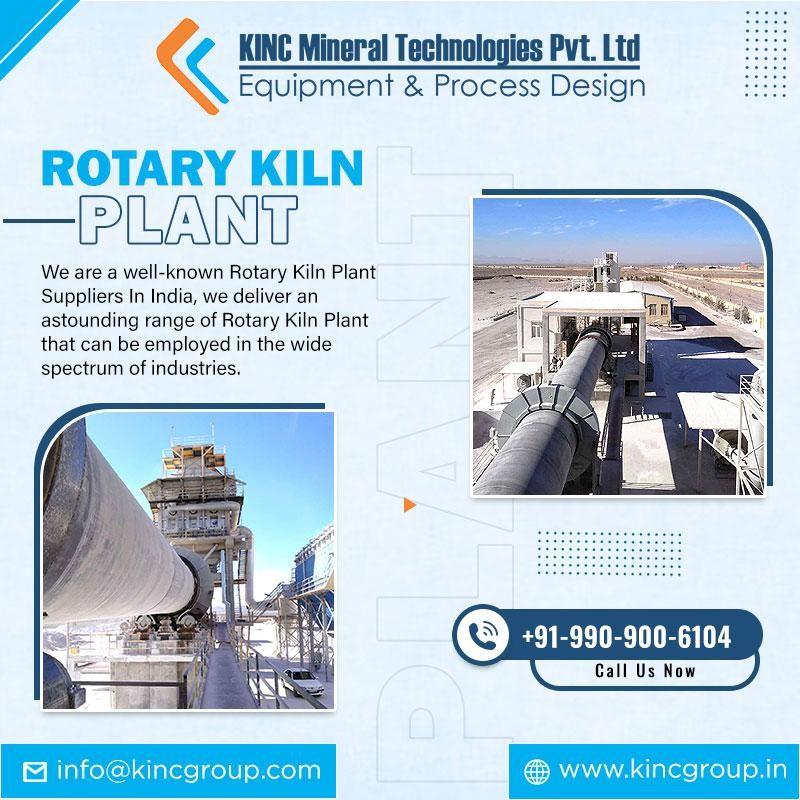A Rotary Kiln is a substantial, constantly revolving cylindrical container employed for elevating raw materials to exceedingly elevated temperatures in an uninterrupted operation. Rotary kilns are pivotal industrial apparatuses extensively employed across an array of procedures, ranging from cement manufacturing to the disposal of perilous materials. In this guide, we will delve into the mechanics of rotary kilns, and their significance in diverse industries, and elucidate how they function to execute vital tasks.
The Operating Principle of A Rotary Kiln
A rotary kiln finds application in various industrial processes, including the manufacture of cement, lime, and other materials. The fundamental operation of a Rotary Kiln entails the passage of material through the revolving kiln while being subjected to heat from a fuel like coal, natural gas, or oil. This high-temperature treatment induces a sequence of both physical and chemical transformations in the material, culminating in the attainment of the desired final product.
The process initiates with the introduction of material at the upper end of the kiln. As the kiln undergoes rotation, the material gradually descends down the slope propelled by gravity. Concurrently, hot gases are introduced at the lower end, moving counter to the material in process.
Typically, these hot gases are generated by igniting fuel in a burner situated at the kiln’s lower extremity. The resultant heat is then transferred to the material through a combination of radiation and convection, prompting a series of chemical and physical transformations like drying, calcination, and sintering. These alterations culminate in the conversion of the raw material into its final form.
To shield the kiln shell from extreme temperatures and corrosive conditions within, a refractory lining, composed of heat-resistant materials, is employed. The support tires and rollers serve to stabilize and facilitate the smooth rotation of the kiln.
Ultimately, the drive gear imparts the requisite torque to set the kiln in motion. This can be achieved through various mechanisms, such as a motor and gearbox or a chain and sprocket system.
While the precise operational details of a rotary kiln may differ based on the specific application and processed materials, the fundamental operational principles remain consistent
How Rotary Kiln Direct-Fired is Different From Indirect Fired
Direct Kiln
A direct-fired kiln is a rotating furnace in which the substance undergoing processing directly encounters the flame and heated gases from the burner. The substance is heated directly, and the gases intimately interact with the material being processed. This kind of kiln is frequently employed for the calcination of high-temperature-demanding substances like limestone, dolomite, and similar materials.
Indirect Kiln
An indirect rotary kiln operates in a way that prevents direct contact between the burner flame and the material undergoing processing. Instead, the heat is transferred to the raw material, like cement, through the kiln shell. This kind of kiln employs a refractory lining to keep the process gases separate from the material being processed. It finds widespread application in the thermal treatment of fine powders and in the manufacture of specialized materials such as activated carbon and char. Numerous leading Rotary Kiln Manufacturers in India craft both direct and indirect kilns, tailoring them to the specific requirements of their users.
Importance of Rotary Kiln In Industries – Why They Are Important?
Rotary kilns play a crucial role in numerous industries by enabling high-temperature processing of materials. These industrial furnaces find application in diverse fields, from cement production to chemical processing, proving particularly valuable for treating materials that are challenging to process through alternative means.
The primary benefit of rotary kilns lies in their capacity to operate at extremely elevated temperatures, reaching up to 3000 degrees Fahrenheit (1650 degrees Celsius). This characteristic renders them highly suitable for tasks demanding high-temperature processing, including calcining, sintering, and roasting. Moreover, rotary kilns exhibit versatility in handling various materials, spanning from fine powders to coarse granular solids, and can accommodate both organic and inorganic substances.
Within the cement industry, rotary kilns are instrumental in generating clinker, an intermediary product essential for cement production. Their application extends to a wide array of processes, encompassing drying, calcination, and reduction.
What Reactions Occur in a Rotary Kiln?
Rotary kilns are versatile vessels capable of achieving various thermal processing goals. They are primarily employed for the following reactions:
- Calcination
- Pyrolysis
- Heat Setting
- Incineration
- Sintering
- Reduction Roasting
- Thermal Desorption
- Organic Combustion
What Is the Difference Between Rotary Kiln & Rotary Dryer?
Rotary kilns and rotary dryers are both rotating drums utilized in various industrial applications, yet they serve distinct purposes and operate on differing principles. Let’s examine the key disparities between rotary kilns and dryers:
Purpose:
Rotary Kilns: These are primarily employed for thermal processing tasks like calcination, reduction, and roasting. These processes entail subjecting a material to high temperatures to induce a chemical or physical transformation.
Rotary Dryers: They are utilized to extract moisture from a material via evaporation or drying. Generally, these dryers operate at lower temperatures.
Design:
Rotary Kilns: They are typically lengthier and possess a larger diameter compared to rotary dryers. The design of a rotary kiln is more intricate, featuring multiple heating zones, cooling systems, and mechanisms for regulating the atmosphere within the kiln.
Heating Method:
Rotary Kilns: These employ either direct or indirect heating methods to attain the requisite temperature for the ongoing process.
Rotary Dryers: They commonly employ direct heating techniques, such as a flame or hot gas, to eliminate moisture from the material under processing.
Summary
Rotary kilns are robust machines crucial to various industrial operations, from cement production to the safe disposal of hazardous materials. They are indispensable in our contemporary industrial landscape. If you’re seeking top-notch rotary kilns, look no further, as we are your ideal comprehensive source.
At Kinc Mineral Technologies Pvt Ltd, we specialize in the design, fabrication, and distribution of premium-grade rotary kilns. As esteemed and dependable Rotary Kiln Suppliers in India, we possess the expertise to tailor these offerings precisely to meet your specific requirements and preferences.



